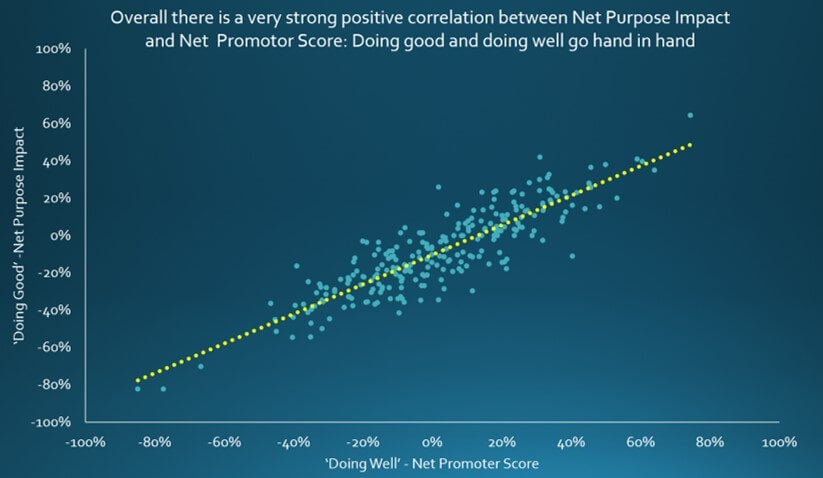Measuring the Purpose of a Brand or Corporation such that, bridging to conventional measures such as shareholder return.

After over 700 daily posts, I repeat themes here. I believe in business as a force for good, so one repeated theme is around the need for reform of capitalism to better serve all stakeholders, not simply shareholders.
Whilst this concept is gaining traction, gaps between “old paradigm” and new thinking on this are becoming obvious, which I see as a great opportunity to identify and bridge gaps in many specific areas.
One of these areas is around CEOs, as my work tends to be with CEOs and their Leadership teams. I love to give real examples of where CEOs are thinking beyond old paradigms of simply short term maximisation of shareholder return etc. One example is: “Time for the Anti-CEO Playbook“, featuring the CEO of Chobani, Hamdi Ulukaya.
Now, today’s title is around another area that must be bridged, on measuring the Purpose of a Brand or Corporation such that, bridging to conventional measures such as shareholder return, one can see and track with statistically accurately both a) that “Doing Good and Doing Well” are closely correlated, and b) track the progress of a brand or corporation over time.
I was excited to see this now out there, so today sharing an article and recommendation of who to talk to in order to do this for you and your brand or corporation.
The following article is by Sean Gogarty of Verum Mundi, who kindly agreed to meet with me directly after publishing this.
To me, a key point here is that this study accurately measures the perception of consumers. No matter what you are doing around purpose, consumers as a collective have a strong “bullshit detector”, so this study not only shows a very strong correlation between “doing well and doing good”, it will tell participating brands and corporations where they really are in the eyes of the consumer.
If you are interested in being part of this study on an ongoing basis for your brand or corporation, do contact Sean at sean@verummundi.com
How Can We Save Capitalism?
(originally published on Linked In, August 21, 2019) by Sean Gogarty
As we have learnt over history, capitalism is a piece of social technology that has no philosophy or morals of its own — it’s a machine that simply does what it does. Of course, capitalism and the market economy do not exist in a vacuum: they rely on property rights backed up by law, as well as money, that other key social technology.
So capitalism exists in a framework. Crucially, it can only operate under license from peoples and governments — and capitalism’s license is under review by an increasingly large proportion of society. The wealth inequality, corruption, lack of inclusiveness and abuse of market power that antisocial capitalism generates is leading millions of people to question if it’s really the best way to organise developed economies.
I believe that capitalism is the least-worst way of organising our productive world, but it must (and can) evolve if it is to survive. All businesspeople have a part to play in this, which is why I am dedicating myself to helping brands and companies find and execute a social value strategy or Purpose.
Purpose is now a competitive dimension, and it has to be at the top of every CEO’s mind if they want to compete and win in their industry. If companies cannot show that the world is a better place for them existing, then they will lose their position to companies that can. This is the evolutionary mutation that capitalism requires to survive, and to be seen as a force for the good of the many, not just the few. If it can evolve successfully, our license to do business will be renewed. If it can’t, expect the worst.
Like many others, I believe that if you can’t measure something then you can’t manage it — that’s why my colleagues and I have created the Net Purpose Impact score. The NPI is a measure of whether or not customers (the public) believe that your company is making the world a better place or not.
We have asked 26,000 questions about 130 top brands in the UK and the USA to determine their Net Promoter Scores — Bain’s measure of preference — and Net Purpose Impact scores, and have subsequently plotted the data. We call one axis ‘Doing Well’ and the other axis ‘Doing Good’; if you have read this far you will quickly work out which is which!
You can see the 130 data points plotted in the chart above. The statistically-minded amongst you will see that there is a very strong correlation between ‘Doing Well’ and ‘Doing Good’ — 75-85% in fact. We urge all leaders to measure their NPI, and to find and powerfully execute their company or brand Purpose. We can measure it, you can manage it, the customers want it — let’s do it!
